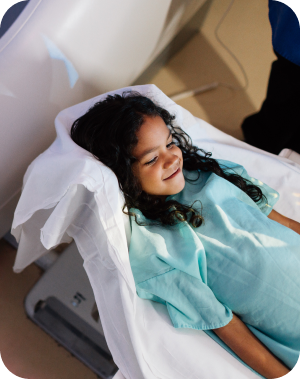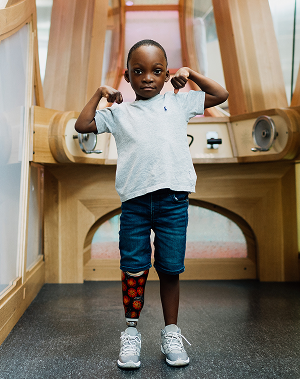craniosynostosis


about condition
Craniosynostosis (kray-nee-oh-sin-o-stow-sis) is a condition normally present at birth. It involves the premature closure/fusion of the skull bones. Cranial sutures are the fibrous bands of tissue (aka fibrous sutures) that connect the bones to the skull. This means the premature fusion prevents the head from growing as it should, and therefore, changes the growth pattern. Since the skull cannot expand perpendicular to the fused sutures, it compensates by growing more in the direction parallel to the closed sutures. At times, the resulting growth pattern may provide the necessary space for the growing brain even if a malformed head shape occurs as a result. However, in cases where enough space is not provided for the growing brain, it results in increased intracranial pressure, possibly leading to visual, sleep, breathing and eating challenges, as well as intellectual disability may occur.
To further explain, in the very first years of life, the sutures serve as the most important centers of growth in the skull. The growth of the brain and the opening of the sutures depend on each other. When the brain grows, it pushes the two sides of the open sutures away from each other, thereby enabling the growth. This means that the brain can only grow if the sutures remain open. When the intracranial pressure is compromised, the sutures will no longer expand which will cause them to fuse and restrict brain growth. This fusion of sutures can affect the bones that form the forehead, the upper sides of the skull, and in some cases, even the back and side of the skull. Facial features can also be affected because of the skull malformations. There are two craniosynostosis categories: isolated (non-syndromic) craniosynostosis and syndromic craniosynostosis. The latter occurs as a result of an individual acquiring a syndrome that includes craniosynostosis. There is no known cause for the isolated occurrence.
Types of craniosynostosis identified by sutures and head shapes:
- Sagittal synostosis (Scaphocephaly)
- Coronal synostosis
- Unicoronal – one side (Anterior Plagiocephaly)
- Bicoronal – both sides (Brachycephaly)
- Metopic synostosis (Trigonocephaly)
- Lambdoid synostosis (Posterior Plagiocephaly)
characteristics and symptoms of this condition are varied (depending on category/type) and may include:
- Misshapen skull; depends on which sutures are affected
- Development of a raised hard ridge along affected sutures
- Different head shapes (short and broad, long and narrow, cloverleaf, etc.)
- Increased intracranial pressure
- Possible abnormal fluid accumulation in cavities of the brain (hydrocephalus)
- Prominent forehead and prominent back of head
- Recessed forehead and flattened back of head
- Flattened forehead on affected side and bulging on unaffected side
- Protruding/bulging eyes (proptosis)
- Widely spaced eyes (hypertelorism)
- Narrowly spaced eyes (hypotelorism)
- Eye issues, such as asymmetrical orbits, strabismus, astigmatism, etc
- Curved nose
- Small underdeveloped upper jaw (hypoplastic maxilla) and protrusion of lower jaw as a result
- Short upper lip
- Dental issues, such as: high arched narrow palate, crowded teeth, upper and lower teeth don’t meet (malocclusion)
- Possible upper airway breathing issues
*Surgical intervention may include cranial vault and/or midface distraction procedures to improve functions early on, as well as other necessary procedures
how do I know if my child will be born with this condition?
Sometimes when an ultrasound is performed during pregnancy, a doctor may notice non-typical signs which require additional testing. More in-depth testing with 2D or 3D ultrasounds or a fetal MRI can reveal much more. After birth, clinical examinations, CT scans, MRI, and other testing can help to diagnose this condition and whether it may be syndromic. (In some cases it is not diagnosed until later in childhood.) For any parent having a known craniofacial syndrome, genetic counseling is highly recommended.


how do you treat craniosynostosis?
The treatment of craniosynostosis is focused on the specific symptoms apparent in each individual since the symptoms can vary widely. Several specialties and physicians may be involved throughout the child’s life. Early surgeries may include craniofacial and reconstructive procedures to correct skull and head malformations to allow the brain to grow and develop properly. Also, there may be possible surgery to relieve any intracranial pressure. Patients may see some or all of the following physician specialties: pediatrician, neurologist/neurosurgeon, ophthalmologist, otolaryngologist (ENT), audiologist, dentist, orthodontist, oral surgeon, geneticist/genetic counselor, social worker and other healthcare professionals. Early intervention may be important to ensure that children with this condition reach their full potential. Special services like physical and occupational therapies along with special education may be very beneficial in some cases.
faqs
Craniosynostosis occurs an estimated 1 in every 2000 births. The majority are isolated cases with only a small amount (15%) being attributed to syndromes. It affects both males and females; however, research indicates that males are affected more than females.
Yes, this is a craniofacial condition that babies are born with, although, it may not be readily apparent at birth. In some syndromes, it may not be diagnosed until the child is a few years old.
Even though surgeries may be in their future, an individual’s life span is usually typical but will depend on the involvement of the condition.
Several causes of premature suture closure have been identified, such as the various genetic mutation changes associated with syndromic craniosynostosis. (Each craniofacial syndrome will have its own unique genetic information for causing that syndrome and its craniosynostosis.) Genes give instructions for creating the proteins that play vital roles in our body. When a mutation change in a gene happens, the protein that is important for building structures is disrupted. Syndromes such as Apert, Crouzon, Jackson-Weiss, Muenke, Pfeiffer, Saethre-Chotzen are examples of syndromic craniosynostosis.
Syndromic craniosynostosis is caused by genetic mutation changes in genes associated with specific syndromes. The cause of isolated craniosynostosis is still greatly unknown; however, it may possibly occur as a result of different factors. These may include medications during pregnancy or environmental factors.
- Apert syndrome
- Crouzon syndrome
- Jackson-Weiss syndrome
- Muenke syndrome
- Pfeiffer syndrome
- Saethre-Chotzen syndrome
here when you need us
Whether you’re looking for the right provider, ready to make an appointment, or need care right now—we’re here to help you take the next step with confidence.
